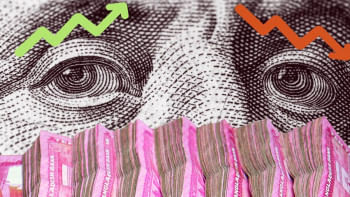What makes Bangladesh the 'champion' of default loans?

The news of Bangladesh occupying the second-highest position in South Asia in terms of a bad loan ratio is no surprise. A World Bank report, titled "Expanding Opportunities: Toward Inclusive Growth," published in April, has positioned Bangladesh just behind Sri Lanka, whose non-performing loan (NPL) ratio is close to 12 percent, while Bangladesh's is close to 10 percent.
Sri Lanka went through a ruinous chapter in 2022. Hence, its sudden NPL ratio increase from 5 to 12 percent should be seen as an exception. But no country in South Asia redefined bad loans as leniently as Bangladesh did. Our unbelievable levels of relaxation for defaulters have helped banks to show the bad loan ratio to be low. This trend, if not checked, is enough to damage the financial stability of an economy.
As the World Development Indicators show, the average NPL ratio from 2012 to 2021 was 10.32 percent for Pakistan, 8.16 percent for Bangladesh, 7 percent for India, and 3.94 percent for Sri Lanka. Sri Lanka was the best performer in loan management in South Asia until 2022, when the country faced its worst financial crisis since its independence. So, its position in the latest WB report really should be treated as an exception.
Though Pakistan tops the list, the position should undoubtedly have been reserved for Bangladesh. Bangladesh Bank greatly relaxed the definition of NPLs, making a bad loan seem like an excellent borrowing, while Pakistan did not dilute the definition of default loans. This portrays the failure of banking governance in Bangladesh. And it has greatly eroded the future of our nation.
Our NPL situation was almost stagnant from 2012 to 2015. From 2016, it began rising and this trend continued until 2019. From 2020, due to the halting nature of the pandemic, the finance ministry started loosening the definition of default loans. This practice encouraged further eruption of NPLs. Any default loan was allowed to be a regular loan if the defaulter adjusted as low as five percent of the total liability. This was imprudent and a clear signal of mass impunity for financial wrongdoers, triggering moral hazards among new borrowers. The cap on the lending rate at 9 percent made borrowing dirt-cheap, further stimulating the borrowing of big groups in business and industry.
There are mainly four reasons why the default culture in Bangladesh became emboldened: 1) The regulator's defective redefinition of default loans; 2) Signalling by authorities that defaulters have been and will always be excused (or even rewarded if need be); 3) Defaulter-friendly leadership at the central bank since 2016; and 4) The lending rate cap that introduced a money-for-cheap-policy for the super-rich, even at a time of high inflation.
The culture of favouring looters or not punishing any of them for financial turpitude has accelerated the renaissance of default loans. And this explains how Bangladesh's default loans have engulfed the financial architecture of the economy in a cancerous fashion.
Additionally, the culture of favouring looters or not punishing any of them for financial turpitude has accelerated the renaissance of default loans. And this explains how Bangladesh's default loans have engulfed the financial architecture of the economy in a cancerous fashion.
There are currently three great threats facing our economy: 1) Increasing fiscal weakness; 2) Increasing default loans; and 3) Unstoppable money laundering. Empowered politicians may seem to be unsympathetic towards money launderers. Policymakers understand how much damage this mafia-like group is incurring by dwindling our foreign exchange reserves. But the ministers seem to never be critical or disapproving of the big tax evaders or loan defaulters.
Herein lies the political economy of the unabating default culture, which the military governments initiated and nurtured for cementing their power base. Subsequently, the democratic governments continued the practice by providing the same wine in a different bottle, just to cultivate support and favour for themselves. The loan default culture seems to be an inevitable reward for the super-rich. These tycoons seek nominations before elections as part of their hidden conditionality. One cannot help but wonder if this is why the government found it more pragmatic to sweeten the definition of bad loans, rather than punishing wilful looters. A myopic move by regimes in turn gave long-term confidence to loan defaulters. Now, they seem untouchable by any regime.
Using window dressing, tycoons show losses and deficits – a stratagem that helps them evade taxes. But where does their money go? The best way is to transfer the funds from the country to overseas – Switzerland, Malaysia, Canada, the US, the UK, and recently the UAE. Default loans, tax evasion, and money laundering are different facets of the same problem. Hence, stripping Bangladesh of its high position in the list of nations with the worst loan ratios is not going to be an easy task.
Loan defaulting is a deeply embedded problem for Bangladesh – just like the mafia problem in Italy, drug lord hegemony in Mexico, and the gunmakers' lobby in the US. Bangladeshi defaulters are clever enough to take advantage of any global downturn, whether it affected Bangladesh or not. Their bad loans have historically gone up even when the country's growth accelerated, defying any economic rationale.
This indicates that bad loans in Bangladesh cannot be sensibly justified. They are here to stay since many businessmen-turned-politicians will always be there to help their cronies relish evading taxes, enjoy being wilful defaulters, and celebrate making fortunes overseas. It's a vicious cycle that likely explains why Bangladesh is almost champion in terms of default loan ratio in South Asia, and may remain so in the future.
Birupaksha Paul is a professor of economics and finance at the State University of New York at Cortland.

 For all latest news, follow The Daily Star's Google News channel.
For all latest news, follow The Daily Star's Google News channel. 









Comments